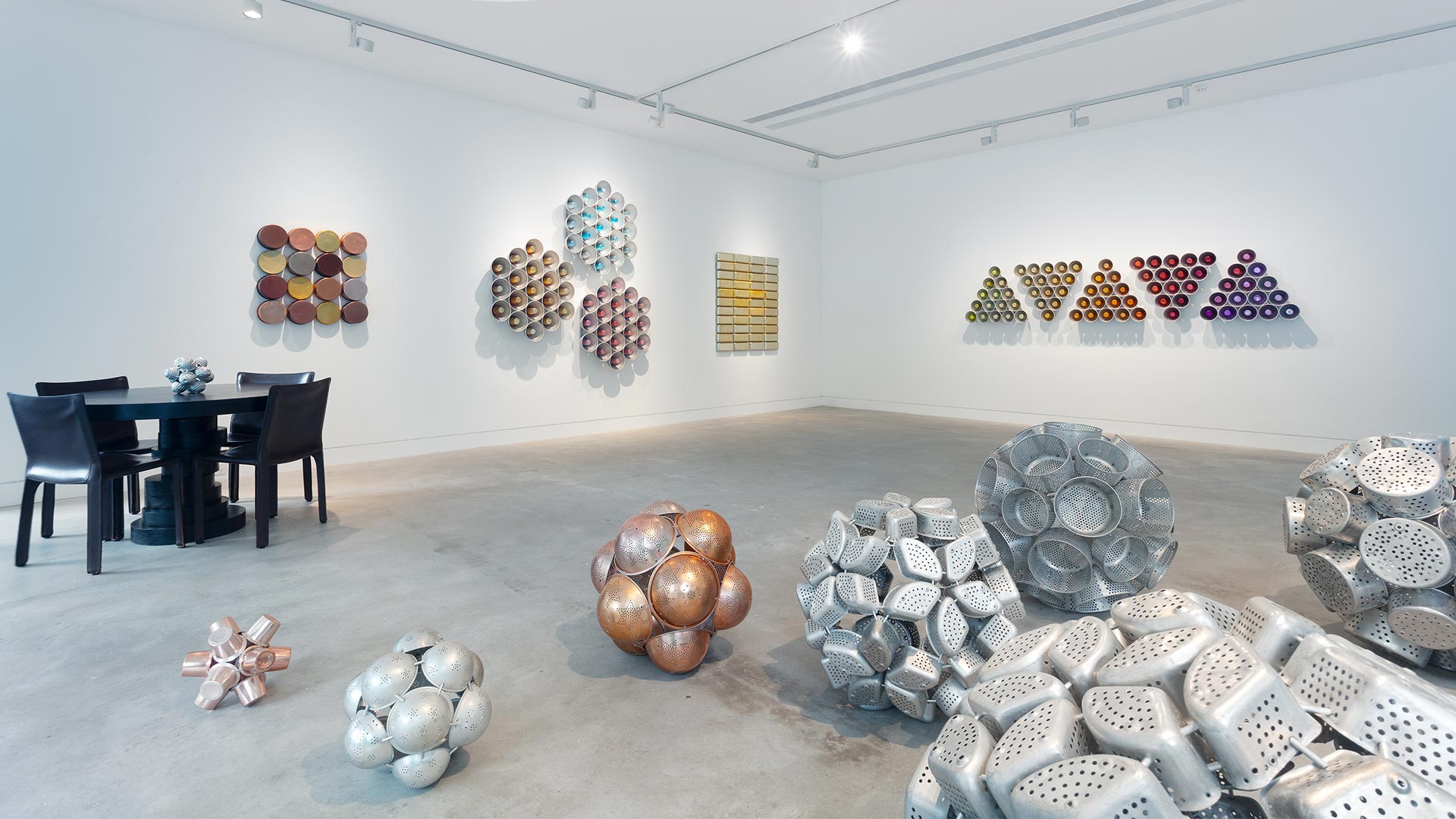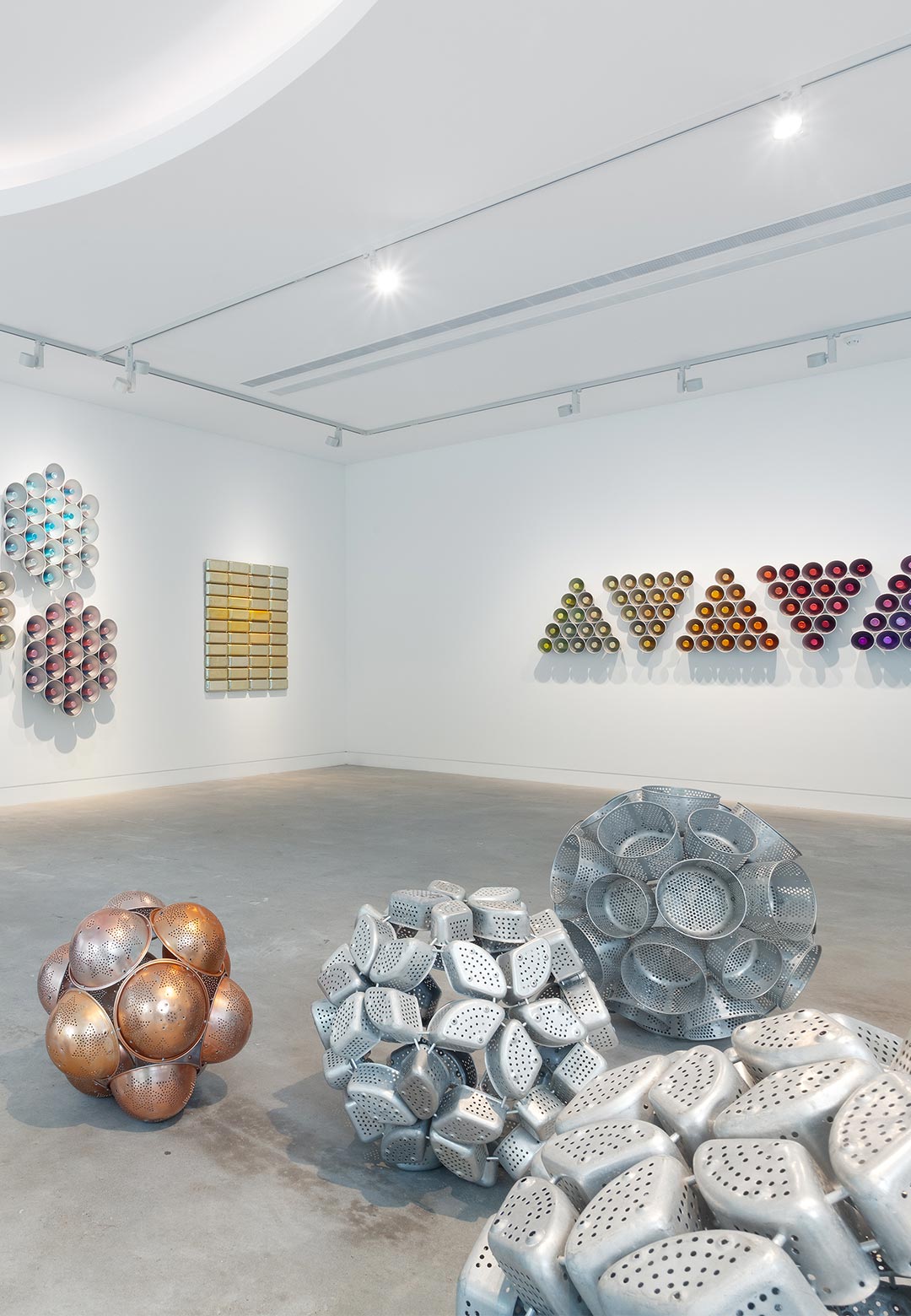Gallery Sally Dan-Cuthbert, an Australian art gallery recently unveiled artist Donna Marcus’ first solo exhibition. Titled Pallet, the exhibit showcases a new sculpture series made of repurposed aluminium cookware. Taking over the ceiling, walls and floor, Marcus’ striking sculptures constitute simple geometric forms and arresting colour compositions that display a complex sculptural harmony and tell a nuanced narrative. While the artworks are made of everyday objects, they display modern and intriguing visual forms. Founded in 2019, Gallery Sally Dan-Cuthbert, located in Sydney, Australia, is a distinctive space that marries modern visual art with collectible design pieces by local and international artists and designers. The venue represents both upcoming and established creatives, with an aim to push boundaries and curate intriguing exhibitions. Pallet offers guests a safe space for reflection and contemplation in which they are encouraged to wander through the show at their own pace, taking in the works sensorially.
At first glance, the exhibition’s sculptures captivate guests by the forms illustrated by a variety of age-old utensils on display—from colanders to electric frypan lids. The primary material of the kitchenware is aluminium, a material that once constituted a major manufacturing industry in Australia. “A homophone of palette, Pallet, as my exhibitions often do, also takes its name from one key work. I have collected domestic aluminium objects for over 30 years—from the 1940s to the 1970s, an era of accelerated standardisation, systemisation, and containerisation. My exhibit showcases a world where every object we use fits efficiently into boxes, into crates, and on pallets,” Marcus tells STIR. “This thought-provoking exhibition takes up the idea of the colour study, using the hues and forms of 20th-century kitchens and their denizens. These culinary artefacts are the modules I often work with and are embedded with meanings from their past lives.”
Donna Marcus is a distinguished Australian artist with a practice that spans more than 30 years. She has showcased her work extensively in Australia and internationally, appearing in several sculpture surveys and award exhibitions at illustrious institutions such as the Museum of Art and Design, New York, the National Gallery of Australia, and the Powerhouse Museum in Sydney. Marcus has been the subject of two survey exhibitions documenting her career. Moreover, her work has been displayed in public and private collections globally, and she has been the topic of a number of scholarly and journalistic publications as well.
Social magnitude
In Pallet, Queensland-based Marcus references minimalism, modernism, and feminism through her unique visual language that links colour and material to memory. By using objects from the kitchen, she alludes to the ideological clash between capitalism and communism, with the kitchen as a symbol of prosperity and modernism. “The kitchen was once a battleground of political contests. Its streamlined modernity is a symbol of ‘progress,’ as Nixon and Krushchev argued in the famous Cold War Kitchen Debate of 1959. Modernist ideas of grids and order and the essence of things are embodied in the reassembly of these humble objects made of miraculous materials and speak to the history of modernism, feminism, and minimalism,” adds the artist.
Materiality
Throughout her career, Marcus assembled old aluminium cookware to create sculptures that exhibit vibrant colours, repetition and patterning. An enchanting element of this show is the combinations of hues that Marcus has realised through collecting similar forms. “I remember in the 1990s, I found a set of small jelly moulds at a market, and was intuitively drawn to their forms and tonal quality. I have spent the last few decades reflecting on that initial response. The overlap of the domestic and the industrial, and the aesthetics of the aeronautical and organic continue to fascinate me. Aluminium is a metal requiring enormous quantities of electricity to refine, and was arguably the real material of modernism with aspirations perhaps no better encapsulated than in the modern kitchen,” remarks the artist.
Marcus’ sensory exhibition of eye-catching sculptures gives new life to discarded kitchenware. Furthermore, this exhibition explores sustainable design and takes it a step further into the spotlight. With the Pallet exhibit, the artist hopes to inspire designers and artists all over the world to experiment and push the boundaries of the kinds of materials that can be used to craft sculptures and artworks. “Collecting the material,” she reminisces, “was initially exciting and a great joy, beginning at a time when I had small children and also worked as a lecturer at the Queensland College of Art. Space to store, the haul of material was always a challenge. The great reward, now, after years of gathering, storing, and sorting, is that the work is a kind of ‘time in lieu’ to revisit and compose. New works emerge from the critical mass gleaned over many years.”
The experience
While the sculptures showcase a minimal design aesthetic, they have layers of meaning that are completely open to interpretation. Describing her observation of people’s experience with the works and her hope for the show, Marcus adds, “I have found that people will bring their own narratives to the work drawn from their memories. Works such as Glint play with a minimalist aesthetic and bring layered histories that are far from minimal. I am interested in how women, in particular, continue to practise and I hope the show communicates the longevity and persistence of these ideas.”
“The series began with After Albers, 1998, and is completed by Glovebox, 2024. Glint is the newest work in the show and unsurprisingly as such is the marker for the next series of works. I believe that exhibiting your work is the opportunity to stand back and review, which inevitably leads to new directions and ideas,” concludes the artist.
'Pallet' by Donna Marcus is on display until May 5, 2024, at Gallery Sally Dan-Cuthbert in Darlinghurst, in the eastern suburbs of Sydney, Australia.






 Sign in with email
Sign in with email










What do you think?